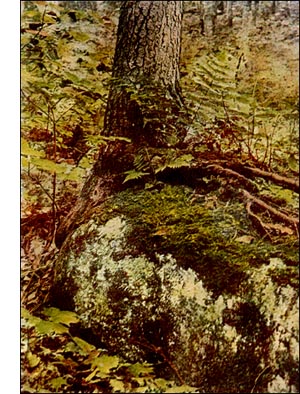Hooked Boat Hook Moss
 The Hooked Boat-hook Mosses, Hypnum (Harpidium) uncinatum, Hedw.
The Hooked Boat-hook Mosses, Hypnum (Harpidium) uncinatum, Hedw.Habit and habitat.-In pale yellowgreen tufts, erect or drooping, on stones bordering streams, or on shaded ground, rarely on decayed wood, common and variable in mountain regions.
Name.-The specific name, Latin uncinatum, hooked, refers to the character of the leaves.
Leaves.-Long, lance-shaped, grooved lengthwise, the taper-point spreading, scythe-shaped or hooked; apex minutely serrate; vein thin; cells narrow, more enlarged at the base, broader and rectangular at the angles, which are slightly hollow.
Leaves at the base of the pedicel (perichaetial leaves).-Very long, the outer recurved from the middle, the inner soft, long, with a slender thread-like point; apex sharply serrate; vein present.
Habit of flowering.-Male and female flowers on the same plant (monoicous).
Veil (calyptra).-Split up one side.
Spore-case.-Nodding, cylindrical, incurved, constricted under the mouth when dry, brown-orange, darker when old.
Pedicel (seta).-Variable in length, smooth.
Lid (operculum).-Orange, highly convex, conical, acute.
Teeth.-Orange at the base, yellowish above; segments of the inner membrane slightly cleft; cilia two, as long as the outer teeth.
Annulus.-Broad, of three rows of cells.
Spores.-Mature in summer and autumn.
Distribution.-Universal.